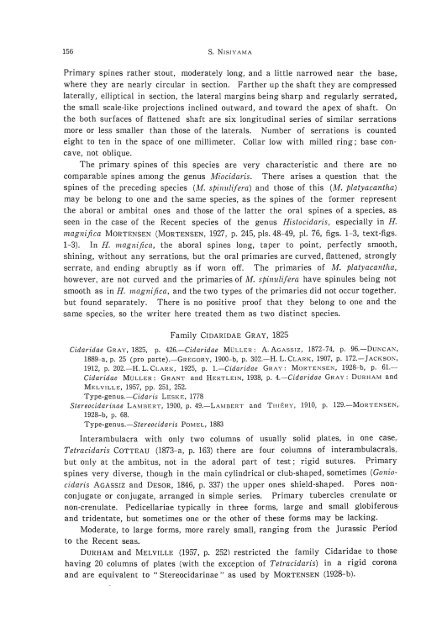the echinoid fauna from japan and adjacent regions part i
the echinoid fauna from japan and adjacent regions part i
the echinoid fauna from japan and adjacent regions part i
Create successful ePaper yourself
Turn your PDF publications into a flip-book with our unique Google optimized e-Paper software.
156 S. NISIYAMA<br />
Primary spines ra<strong>the</strong>r stout, moderately long, <strong>and</strong> a little narrowed near <strong>the</strong> baser<br />
where <strong>the</strong>y are nearly circular in section. Far<strong>the</strong>r up <strong>the</strong> shaft <strong>the</strong>y are compressed<br />
laterally, elliptical in section, <strong>the</strong> lateral margins being sharp <strong>and</strong> regularly serrated,.<br />
<strong>the</strong> small scale-like projections inclined outward, <strong>and</strong> toward <strong>the</strong> apex of shaft. On<br />
<strong>the</strong> both surfaces of flattened shaft are six longitudinal series of similar serrations·<br />
more or less smaller than those of <strong>the</strong> laterals. Number of serrations is counted<br />
eight to ten in <strong>the</strong> space of one millimeter. Collar low with milled ring; base concave,<br />
not oblique.<br />
The primary spines of this species are very characteristic <strong>and</strong> <strong>the</strong>re are no<br />
comparable spines among <strong>the</strong> genus Miocidaris. There arises a question that <strong>the</strong><br />
spines of <strong>the</strong> preceding species (M. spinulifera) <strong>and</strong> those of this (M. platyacantha)<br />
may be belong to one <strong>and</strong> <strong>the</strong> same species, as <strong>the</strong> spines of <strong>the</strong> former represent<br />
<strong>the</strong> aboral or ambital ones <strong>and</strong> those of <strong>the</strong> latter <strong>the</strong> oral spines of a species, as·<br />
seen in <strong>the</strong> case of <strong>the</strong> Recent species of <strong>the</strong> genus Histocidaris, especially in H.<br />
magnifica MORTENSEN (MORTENSEN, 1927, p. 245, pIs. 48-49, pI. 76, figs. 1-3, text-figs.<br />
1-3). In H. magnifica, <strong>the</strong> aboral spines long, taper to point, perfectly smooth,<br />
shining, without any serrations, but <strong>the</strong> oral primaries are curved, flattened, strongly<br />
serrate, <strong>and</strong> ending abruptly as if worn off. The primaries of M. platyacantha,<br />
however, are not curved <strong>and</strong> <strong>the</strong> primaries of M. spinulifera have spinules being not<br />
smooth as in H. magnifica, <strong>and</strong> <strong>the</strong> two types of <strong>the</strong> primaries did not occur toge<strong>the</strong>r,<br />
but found separately. There is no positive proof that <strong>the</strong>y belong to one <strong>and</strong> <strong>the</strong><br />
same species, so <strong>the</strong> writer here treated <strong>the</strong>m as two distinct species.<br />
Family CIDARIDAE GRAY, 1825<br />
Cidaridae GRAY, 1825, p. 426.-Cidaridae MULLER: A. AGASSIZ, 1872-74, p. 96.-DuNCAN,<br />
1889-a, p. 25 (pro <strong>part</strong>e).-GREGORY, 1900-b, p. 302.-H. L. CLARK, 1907, p. 172.-JACKSON,<br />
1912, p. 202.-H. L. CLARK, 1925, p. 1.-Cidaridae GRAY: MORTENSEN, 1928-b, p. 61.<br />
Cidaridae MULLER: GRANT <strong>and</strong> HERTLEIN, 1938, p. 4.-Cidaridae GRAY: DURHAM <strong>and</strong><br />
MELVILLE, 1957, pp. 251, 252.<br />
Type-genus.-Cidaris LESKE, 1778<br />
Stereocidarinae LAMBERT, 1900, p. 49.-LAMBERT <strong>and</strong> THIERY, 1910, p. 129.-MoRTENSEN,-<br />
1928-b, p. 68.<br />
Type-genus.-Stereocidaris POMEL, 1883<br />
Interambulacra with only two columns of usually solid plates, in one case,<br />
Tetracidaris COTTEAU (1873-a, p. 163) <strong>the</strong>re are four columns of interambulacrals,<br />
but only at <strong>the</strong> ambitus, not in <strong>the</strong> adoral <strong>part</strong> of test; rigid sutures. Primary<br />
spines very diverse, though in <strong>the</strong> main cylindrical or club-shaped, sometimes (Goniocidaris<br />
AGASSIZ <strong>and</strong> DESOR, 1846, p.337) <strong>the</strong> upper ones shield-shaped. Pores nonconjugate<br />
or conjugate, arranged in simple series. Primary tubercles crenulate or<br />
non-crenulate. Pedicellariae typically in three forms, large <strong>and</strong> small globiferous·<br />
<strong>and</strong> tridentate, but sometimes one or <strong>the</strong> o<strong>the</strong>r of <strong>the</strong>se forms may be lacking.<br />
Moderate, to large forms, more rarely small, ranging <strong>from</strong> <strong>the</strong> Jurassic Period<br />
to <strong>the</strong> Recent seas.<br />
DURHAM <strong>and</strong> MELVILLE (1957, p. 252) restricted <strong>the</strong> family Cidaridae to those<br />
having 20 columns of plates (with <strong>the</strong> exception of Tetracidaris) in a rigid corona<br />
<strong>and</strong> are equivalent to "Stereocidarinae" as used by MORTENSEN (1928-b).












